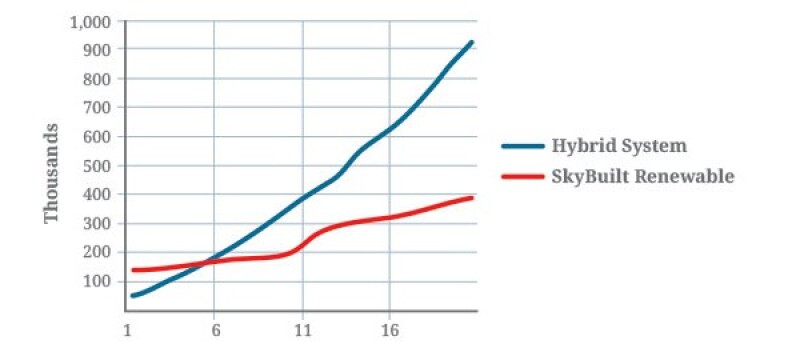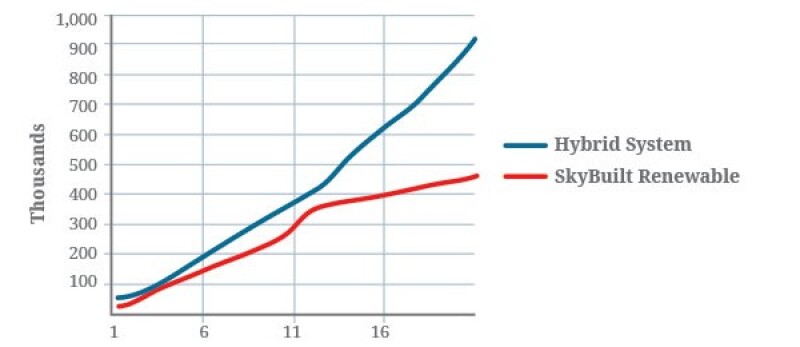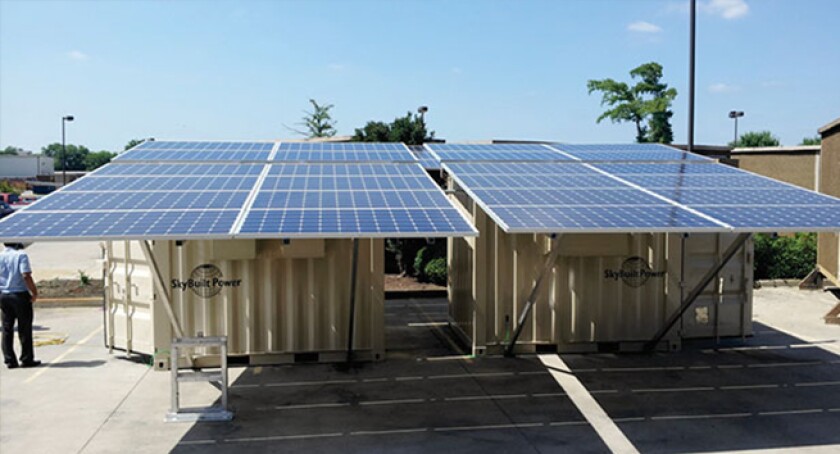When a renewable energy solution evolves from powering military forward command centres, you know it’s going to be rapidly deployable, robust and reliable. SkyBuilt Power have partnered with Magellan to build an integrated renewable energy system designed to meet the specific needs of emerging market tower operators. With SkyBuilt’s first prototype about to be shipped to Helios Towers Tanzania, TowerXchange caught up with SkyBuilt President and CEO Ken Schweers.
TowerXchange: Please introduce our readers to SkyBuilt Power.
Ken Schweers, President and CEO, SkyBuilt Power:
SkyBuilt Power was founded in 2002 with a focus on renewables for off grid generator replacement. Our initial solutions were for military and intelligence applications, where power at remote sites such as forward command posts required ruggedized solutions, efficient logistics, rapid deployment and low maintenance. Our objective was always to work with the military and intelligence communities to design and build out our solution, so now we’re looking at commercial applications such as telecommunications.
I see renewables as three distinct markets; a large central station power market, a commercial and residential market, and a middle market that requires more sophistication to design and customize solutions to meet the specific requirements of military, intelligence or telecommunication clients.
SkyBuilt Power is a systems integrator - we don’t manufacture our own systems but rather use best of breed COTS (Commercial Off The Shelf) components, integrated into designs that bring robustness and sophistication to renewable energy and fit the needs of our clients.
While we’ve designed systems of up to 60kW, the 15kW continuous power requirement and under is the sweet spot for us - we’re generally focused on smaller systems for the diesel replacement market and on rugged applications for remote areas.
While our initial focus is on off grid sites, grid conditioning is built in to our system. Depending on the pricing of grid power, 8-10 hours of grid availability makes the economics for renewables less strong. We could see ourselves targeting sites with 5 hours or less grid power, but for now our priority is off grid.
SkyBuilt Power has previously done some work with Verizon and Homeland Security to integrate renewables into existing tower power systems in outreach areas, but there weren’t a lot of applications for off grid power in the US. With the US government’s declining budget and withdrawal from Iraq and eventually Afghanistan, our business required a change of direction when I came in as President and CEO in July last year.
Tower operators in Africa are being eaten alive by energy opex
TowerXchange: How did SkyBuilt Power get into emerging market telecoms?
Ken Schweers, President and CEO, SkyBuilt Power:
Jim Treptow, Chairman and CEO of Magellan, came to us and suggested a partnership that moved SkyBuilt into off grid telecommunications in the developing world. Magellan has a hsitory of developing renewable and energy waste recovery projects in the U.S.
Tower operators in Africa are being eaten alive by energy opex. Jim and Chuck Green, CEO of Helios Towers Africa (HTA), have known each other for many years. During a telephone conversation last Fall, Jim raised the question as to whether HTA had used renewables for their off grid power requirements. One conversation led to another and a joint effort was undertaken to design an ideal solution which met HTA’s multi-tenant power needs. No procurement or supply promises have been made either way; but each of our companies will be able to use the test data to determine performance and economic feasibility.
Our solution for Helios had to be economic, it had to be robust and secure, it had to be designed with the challenges of inland transportation in Africa in mind, and it had to operate in higher temperatures, although conditions are more moderate in Tanzania than in some African countries. So we’ve designed a system for Helios that combines solar panels, batteries, EMS and a backup generator, all contained and split across two ISO containers to simplify inland transportation. The system is also being designed to accommodate the hotter temperatures experienced by Helios and other tower companies in other parts of Africa. When we get to the site, we put the containers together, suspend PV panels from them to get a complete renewable energy system in a box - or two boxes!
We’re getting ready to deploy first of two prototypes next month. Once tested, we’re keen to sell units to Helios Towers Africa and other emerging market tower operators.
Investment in renewables means towercos are able to double up on value creation, both through the core recurring lease up revenue side of the business, and a parallel asset value creation on the power side
TowerXchange: Do you see an alignment between towercos’ longer term investment perspective in real estate and towers, and the longer term perspective required to invest in renewables?
Ken Schweers, President and CEO, SkyBuilt Power:
SkyBuilt is betting a lot of resources on the marketplace for off grid renewable energy in telecommunications, and to fill out a full business proposition to support it. We‘re excited about this opportunity because we feel that the fundamental economics of towercos, with their longer term focus on creating value, mean they often come out strongly in favour of renewables with their strong life cycle economic advantages over diesel generators or even the newer hybrid systems currently being deployed.
As towercos wrestle with trying to improve margins while competition puts pressure on core lease up revenue growth, and the cost of capital continues to rise, there is a growing need to reduce costs in order to achieve EBITDA projections and improve the economic value of the towerco.
The towerco business model is predicated on passive infrastructure asset acquisitions that have a lifetime of 20+ years. They’re building economic value to capitalize in the future. We need to persuade towercos to apply the same long-term thinking to renewable power systems as they apply to real estate.
Even if they have a three to five year exit strategy, investment in renewables means towercos are able to double up on value creation, both through the core recurring lease up revenue side of the business, and a parallel asset value creation on the power side.
The cost of diesel won’t be going down any time soon! The real payoff is years 7-20 as the spread between cost of renewables and DG+hybrid widens dramatically.
What attracts me to renewable energy for telecom cell sites as an investment opportunity is that there is no dependence on tax breaks or policy decisions, and no need for carbon credits to make the economics work. The straight up economic case is quite compelling.
TowerXchange: How can we build the business case for investment in renewable energy, and resultant reductions in opex, when African operators’ capital continues to be attracted to investment in revenue generating network extension?
Ken Schweers, President and CEO, SkyBuilt Power:
Tower operators want to minimize their short term capital outlay on opex reduction initiatives, yet they also want robust, secure, reliable, temperature controlled, low maintenance solutions. This drives up the specification and therefore the cost.
The fundamental economics for investment in renewables are undeniable given the savings made between running DG and using renewables, so we’re seeking to develop and offer a financing mechanism that allows us to partner with tower operators and share risk and savings. We think this will help overcome tower operators’ reluctance to invest in capital intensive, low maintenance cost renewable energy solution, which are constantly played off against the short term need to achieve profitability.
Cumulative capex and opex for tower power options - outright purchase

Cumulative capex and opex for tower power options - purchase with 10-year export-import financing

TowerXchange: What’s your view on the energy service company (ESCO) business model using power purchase agreements (PPAs) to sell energy by the kWh?
Ken Schweers, President and CEO, SkyBuilt Power:
ESCOs and PPAs in Europe and US took years to develop, and had to be based on a long history of demonstrable performance so banks could understand the risks of the arrangement. There isn’t that history in Africa. It’s not yet clear how the ESCO business model would incorporate dealing with fuel theft, and with capacity expansion for multiple tenants when in many cases the deployment supports a single tenant tower at the outset.
The ESCO business model only works when cheap debt financing can be secured, leveraged against a substantial and long duration contract with one or more tower operators. In the absence of lengthy performance history in Africa, only equity financing is available to would-be ESCOs, so the cost of that financing is prohibitive, especially if tower operators want to transfer much of the operational risk to ESCOs and squeeze margins down to the minimum.
SkyBuilt is willing to follow the market and develop an ESCO proposition when the time is right, but I tend to agree with financial analysts who think this model is five years away - trying to run the marathon before you can crawl is difficult!
TowerXchange: Changing topic, the telecoms industry is familiar with Rapid Deployment towers, tell us about your rapid deployment energy solution.
Ken Schweers, President and CEO, SkyBuilt Power:
We’re designing a renewable energy system as easy to deploy as a diesel generator.
In the past, renewable power systems have been a composition of a variety of stove piped solutions; rectifiers from one company, batteries from another, PV panels from a third et cetera - you add it all together and you hope it works! In reality renewables have incredible amount of interconnected systems, and it only takes one key component to be incompatible or incorrectly fitted to make the whole thing unreliable or simply not functioning.
Our concept is to build a system that integrates all the electrical components in advance. Then we put it in a couple of containers and send it to the site, leaving just the civil work and simple mechanical connections to be completed. So it’s easy to erect without strong technical capabilities at the site.
We’re technology agnostic so we can integrate different generators, rectifiers, PV systems et cetera, enabling us to plug and play the latest technology evolutions, and meet the needs of clients who might want to integrate a specific component or generator to ensure consistency of maintenance and spare parts across their tower portfolio.
SkyBuilt Power designed energy solutions for military forward operating bases, so we’re used to the absolute necessity that solutions have to be fully integrated and deployable - in that context, it has to work!
TowerXchange: How do the needs of multiple tenant cell sites differ from single tenant towers, and how do you upgrade your power solution to add additional tenants?
Ken Schweers, President and CEO, SkyBuilt Power:
Our systems are designed so the energy source of last resort is the diesel generator (DG). If you have a renewable system with a higher capacity, you tend to need less DG runtime with less tenants. Again it comes down to fundamental economics - is it cheaper to use the DG as the variable for energy, or do you build out an expandable system and import additional batteries and PV as you need more capacity? The highest cost component is usually energy storage, so adding more batteries means a higher tariff, thus making it more expensive to import batteries as stand alone items rather than as part of a total energy system or solution. So the answer will vary from site to site. Either approach is doable the question is which is most appropriate and economic.
The cost of PV is relatively low now, often roughly equal to the cost of transportation and installation, so in many cases it’s worth installing full PV capability from outset, even if you’re starting with a single tenant.
Rather than building out redundant capacity to be used in the event of future co-location sales, a key component of a multi-tenant power strategy could be to share in the risk and upside with the towerco, structuring financing on scalable units with tiered financing payments that mirror towercos’ revenue streams. The preferred strategy might depend on how bullish the towerco feels about their potential tenancy ratios.
If towercos can figure out how to integrate renewable energy systems through strategic partnerships with companies like SkyBuilt, I feel they can unlock greater capital value creation than if they focus purely on co-location sales and buying commoditized diesel-centric power solutions.
TowerXchange: So should tower operators consider procurement of renewables as a distinct investment decision from procurement of diesel generators?
Ken Schweers, President and CEO, SkyBuilt Power:
Renewables is a less commoditized market than diesel generators.
If renewables only yielded a 10% improvement in energy opex, I’d agree with treating renewable energy as a commodity. However, given that we can unlock a 50%+ improvement in energy opex, the main component of site level profitability in Africa, that should be an incentive for tower operators to figure out a new approach to this!
TowerXchange: What is the forecast timeline to RoI in your system?
Ken Schweers, President and CEO, SkyBuilt Power:
Like every new technology innovation, we’re in the Catch 22 situation of trying to penetrate market with a higher cost base, needing volume to secure production cost reductions and therefore reduce our prices.
Tower operators are looking for a two and a half to three year payback on integrated, off grid renewable power systems. Right now, we’re at a four to five year payback, but we’re working with our towerco client to identify and remove “nice to have” features, value engineering our system to reduce costs by 25-30%.
But I believe thinking purely in terms of the payback period can be shortsighted. In terms of long term value creation, there is a trade off between capital intensive, low opex solutions and low capital, high opex solutions. If EBITDA is a measure of fundamental valuation for towercos, then there should be the ability to value the higher depreciation of the renewable power systems compared to the earlier earnings that might be achieved for the first five years of operations with diesel generators. Beyond the five year period the depreciaton component and the savings on opex that drives to higher earnings clearly favor the more capital intensive renewable power systems. The asset values created by the 20+ year lifecycle of our systems are substantial.
If you invest in robust solutions that can run at higher temperatures, avoiding the parasitic load of substantial air conditioning, you not only reduce energy opex but you free energy capacity for additional tenants.
TowerXchange: Given SkyBuilt’s experience in public safety, military and other government networks, what’s your view on the requirements and potential of such clients as tower tenants?
Ken Schweers, President and CEO, SkyBuilt Power:
Fundamentally they have two different paradigms for the location of towers and operations: towercos and mobile network operators make commercial decisions based on population density and disposable income, whereas homeland and security network coverage is purely geographic, so they may seek sites that aren’t commercially viable for towercos. But there will be areas of overlap. So for example towercos in the US are looking at public safety networks as potential tower tenants, and at opportunities to provide technical support where the public safety network extends beyond the reach of commercial network coverage.
We’ve made a huge effort to understand the requirements of remote cell site power systems in Africa, adapting to the limitations of inland transportation, integrating sensors and alarms to address security concerns, and creating robust electronics able to operate in high temperature environments with the minimum of air conditioning
TowerXchange: Do you forsee an extension of your business model from providing power to telecom cell sites to community power initiatives?
Ken Schweers, President and CEO, SkyBuilt Power:
Given my background in energy and environmental policy - I used to be COO of Development Alternatives Inc. - I have an underlying desire to extend off grid power solutions for telecom towers, and to use that as a stepping stone to provide broader community power for developmental purposes.
We’re looking for ways to have charging stations at sites to ensure community buy-in, and to use telecom power as the anchor tenant for microgeneration that also improves power and water availability for local communities.
TowerXchange: To sum up, how would you differentiate SkyBuilt Power from your competitors?
Ken Schweers, President and CEO, SkyBuilt Power:
Because we come from a military and intelligence background, we offer ruggedized, fully integrated renewable energy systems deployable into remote environments. We know how to make the pieces fit together and we’re used to working with clients for whom reliability is critical. Our systems are designed to be easy to transport and easy to install.
We’ve made a huge effort to meet the requirements of remote cell site power systems in Africa, adapting to the limitations of inland transportation, integrating sensors and alarms to address security concerns, and creating robust electronics able to operate in high temperature environments with the minimum of air conditioning.
As a new player in the telecoms market, we’re open to customizing our design to meet the specific requirements of clients in a cost effective manner.

